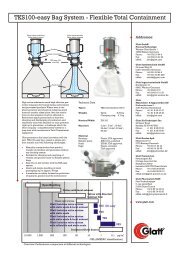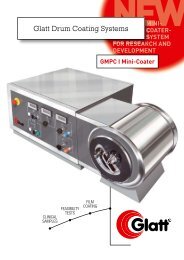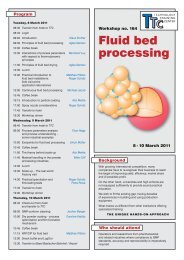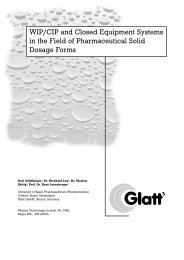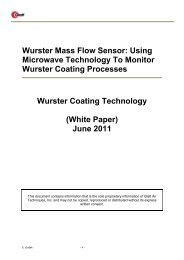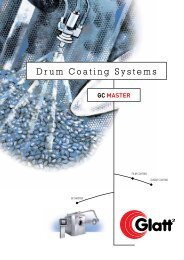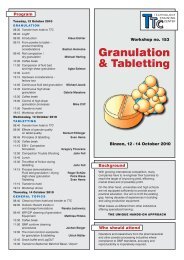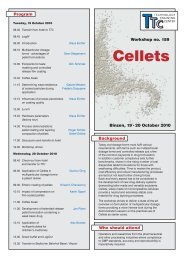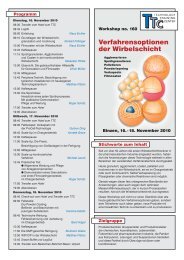No. 30 - Glatt
No. 30 - Glatt
No. 30 - Glatt
Create successful ePaper yourself
Turn your PDF publications into a flip-book with our unique Google optimized e-Paper software.
Enteric coating of pharmaceutical products<br />
By Krisanin Chansanroj<br />
Enteric coating formulations<br />
Enteric coating is aimed to prevent the formulations from gastric<br />
fluid in the stomach and release the drug component in the intestinal<br />
region. Based on this approach, enteric coating is suitably applied<br />
for drugs which cause gastric irritation or are deteriorated by<br />
the gastric fluid or gastric enzyme.<br />
Enteric coating polymer<br />
With an acid-resistant property, enteric coating polymers generally<br />
possess free carboxylic acid groups on the polymer backbone.<br />
They are insoluble in acidic media but become deprotonated and<br />
dissolved in basic media at nearly neutral pH values (pH>5). Enteric<br />
coating polymers can be classified into 3 groups based on<br />
chemical compositions as listed below:<br />
Polymethacrylates<br />
Methacrylic acid/ethyl acrylate<br />
Cellulose esters<br />
Cellulose acetate phthalate (CAP)<br />
Cellulose acetate trimellitate (CAT)<br />
Hydroxypropylmethylcellulose acetate succinate<br />
(HPMCAS)<br />
Polyvinyl derivatives<br />
Polyvinyl acetate phthalate (PVAP)<br />
Solubility of the polymers depends on the number of carboxylic<br />
acid groups varied in the composition. Commercial enteric coating<br />
polymers are available as powder, aqueous dispersion and organic<br />
solution.<br />
Enteric coating formulations need special care of coating operation<br />
due to the constrain of drug release specified in the regulatory requirements.<br />
Enteric formulations should have less than 10% drug<br />
release after 2 hours in the acid stage. The completion of the drug<br />
release in the continuation testing in the buffer stage should take<br />
place within 45 min.<br />
Organic solution and aqueous dispersion<br />
Generally, enteric coating polymers dissolve well in organic solvents,<br />
giving a stable coating solution that facilitates faster coating<br />
processes due to easy evaporation of organic solvents. However,<br />
the practical use of organic solvents in pharmaceutical formulations<br />
has decreased since organic solvent residues in final products<br />
are restricted by the authorities. Flammability of organic<br />
solvents and their toxicity to operators, as well as their harmfulness<br />
to the environment are further reasons. These concerns encourage<br />
the use of aqueous dispersion systems with <strong>30</strong>-40% wt. dry polymer<br />
dispersed in water systems, assisted by surfactants. The last<br />
years efforts have been made to develop ready to use dispersions<br />
which include all auxiliary components such as plasticizers, opacifiers,<br />
and antifoaming agents.<br />
However, the film formation process based on organic solvents and<br />
aqueous dispersions is basically different. The polymer in the organic<br />
solutions undergoes sol to gel transitions during solvent<br />
evaporation whereas polymer particles in aqueous dispersions deposit<br />
layer by layer on the surfaces of the coating substrates. Whilst<br />
water evaporates, polymer particles approach each other, due to<br />
capillary force, and gradually fuse to a uniform layer [1]. Therefore<br />
the size of polymer particles in the dispersion could influence film<br />
formation. The smaller the particles are, the larger the contact area<br />
between the polymer particles becomes. This accelerates polymer<br />
coalescence [2]. By consequence a lower amount of dry polymer<br />
is required for the enteric protection [3].<br />
8<br />
Enteric coating based on aqueous dispersion systems has also<br />
some limitations. Coating processes take longer than with organic<br />
solvent systems as there is more energy required to evaporate<br />
water than for solvents. This could increase the deterioration of<br />
heat- and/or moisture-sensitive drugs during coating processes<br />
[3]. Furthermore, the aqueous dispersion systems are generally<br />
susceptible to coagulation because of a number of factors, such<br />
as additions of fine powder pigments or wetting agents, high shear<br />
gradients during mixing and pH change. Therefore, the preparation<br />
of coating dispersion needs careful operations following the directions<br />
for use suggested by the producer.<br />
Plasticizer<br />
Success of enteric coating efficiency mostly relies on the addition<br />
of plasticizers. Plasticizers are a group of auxiliary components that<br />
improve elasticity of the polymeric film which is generally rigid and<br />
breakable. Plasticizers reduce the minimum film forming temperature<br />
(MFFT) of the polymers, softening the polymeric film at lower<br />
temperature. This improves the spreadability of the polymer on the<br />
surface of the coating substrates and generates a smoother surface<br />
texture of the coating layer [3].<br />
The type of plasticizer should be selected carefully as it influences<br />
the film brittleness [4], compatibility with the coating substrates [5]<br />
and product stability [3, 5]. Hydrophilic plasticizer, triethyl citrate,<br />
is reported to improve the property of Eudragit L <strong>30</strong> D-55 film in<br />
the soft gelatin capsule formulations regardless of the type of filled<br />
liquid whereas hydrophobic plasticizer, tributyl citrate, gives satisfactory<br />
enteric protection only with hydrophobic filled liquid [5].<br />
The latter plasticizer could migrate to the hydrophobic filled liquid<br />
upon storage, resulting in the reduction of the enteric protection.<br />
Besides the plasticizer type, the amount of plasticizer is important<br />
for film flexibility. Insufficient amount of plasticizer causes the film<br />
blistering which could lead to a premature drug release in acidic<br />
media, as shown in Figure 1. However, high amount of plasticizer<br />
reduces the strength of the film and may accelerate the water uptake<br />
into the cores upon storage.<br />
A B C<br />
Fig. 1: Enteric coated tablets with insufficient plasticizer; (A) before dissolution<br />
test, (B) and (C) after dissolution test in the acid stage for 1 and 2 h, respectively.<br />
Subcoating<br />
The major concern in enteric coating formulations is a risk of premature<br />
drug release through the enteric coating film in acid media.<br />
This problem could be solved by an application of a subcoating<br />
layer where the coating substrates are subject to coating with a<br />
small amount of a soluble material, i.e., HPMC, amylopectin, prior<br />
to enteric coating. This thin film layer impedes water penetration<br />
through the cores and thus prevents the premature drug release.<br />
Subcoating is supportive in formulations which contain highly<br />
water-soluble drugs [6-8]. This is where premature drug release<br />
mostly occurres. On the contrary, subcoating could also enhance<br />
the release of acidic drugs in basic media. This causes a problem<br />
of acidic microenvironment at the interface between the core and<br />
the enteric film. The migration of diffused drug through the interface<br />
results in the delay of drug release in basic media [9].<br />
Times <strong>No</strong>. <strong>30</strong> · December 2010



